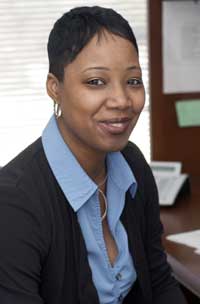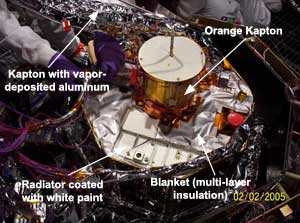 |
Donya Douglas, Thermal Engineer
for ST5 and ST8
|
A man stands in a chilly room with his back to the fire. He muses, "Well, my backside is roasting and my front is freezing. So, on average, I'm quite comfortable."
That assessment of overall well-being may work for a philosopher, but it won't work for a spacecraft. The computers, scientific instruments, imagers, and other electronic equipment in a spacecraft operate well only within a reasonable range of temperatures. In space, maintaining the entire spacecraft within this range is a major design issue, one which is the job of the thermal engineer.
Donya Douglas is the primary one to take on that responsibility for the New Millennium Program's Space Technology 5 (ST5) mission. Its three TV-sized satellites have presented special thermal engineering challenges because of their small size, their initially highly elliptical Earth orbit, and the need to keep them lightweight.
 |
ST5 Spacecraft #1 undergoes testing
in the thermal-vacuum chamber.
|
The thermal control system must maintain spacecraft and component temperatures within acceptable ranges during every phase of the mission, including a one-hour eclipse. And it must do all this passively-with no moving parts, no power consumption whatsoever. Typically, spacecraft have on-board survival heaters. However, since the ST5 spacecraft are so small, there is no extra power to run them. So, the thermal control design has made use of electrically conductive thermal coatings, multi-layered insulation blankets, temperature sensors, conductive thermal isolators, and thermal interface fillers. Creating a further challenge has been the fact that it was not until late in the formulation phase of the mission that the launch vehicle was selected. But even as the launch vehicle considerations changed and the planned orbit changed, the thermal system design has remained the same.
As difficult as designing a thermal system for ST5 has been, Douglas is happy for the challenge. She knew at age 10 she wanted to be an aerospace engineer, maybe even an astronaut. Her father was an electrical engineer who shared his interest in science and technology with Donya and her three sisters. "He was constantly telling me that I could be and do anything I wanted," says Douglas. He particularly valued education, and encouraged Donya in her interest and aptitude in math and science.
She remained focused on her early goal, declaring in her high school senior yearbook that she would be going to work for NASA as an aerospace engineer. Off she went to the University of Maryland and earned a degree in mechanical engineering. During the summer between her second and third years, she interned at NASA Goddard Space Flight Center`s Wallops Flight Facility. The summer job evolved into a co-op student position at Goddard. On schedule with her original plan, she became a full-time NASA aerospace engineer in 1994.
Alongside her work at Goddard on Space Technology 5 and now also on Space Technology 8, she is enrolled in the Accelerated Leadership Program, a 24-month stint of on-the job and classroom training, cohort sessions, coaching and mentoring and other growth catalyzing activities. Having attained full technical mastery in their positions, participants in this program prepare for solving complex organizational problems, negotiating solutions, and generally improving their organizational and managerial skills to fill Goddard's future needs for leadership.
Douglas also chairs Goddard's Women's Advisory Committee, whose vision is "To promote an organizational climate that empowers, encourages, and recognizes the strengths of women in the workforce as vital to the success of the Goddard Space Flight Center's mission." Douglas says, "One of my favorite quotes is 'To whom much is given, much is required.' So I serve on WAC, and I talk to students, and I try to inspire young women."
Her engagement in the welfare of those around her extends to boys too, especially to her own three sons, 15, 15 (twins), and 12 years old. Asked about the challenge of keeping up with them and a career both, she says, "They are proud to have a mom who works for NASA. So they help out a lot." Douglas is involved in her sons' education, advocating not only for them, but also for other students and parents. She talks to classes at school, she is active in the PTA, and she voices her appeals on behalf of students to local school board members.
Using insulating "space blankets" and paints with varying optical properties, Douglas helps create an optimal environment for the spacecraft's instruments to achieve their potential. Through her leadership, mentoring, and advocacy work, she strives to create the same effect for the people around her.

